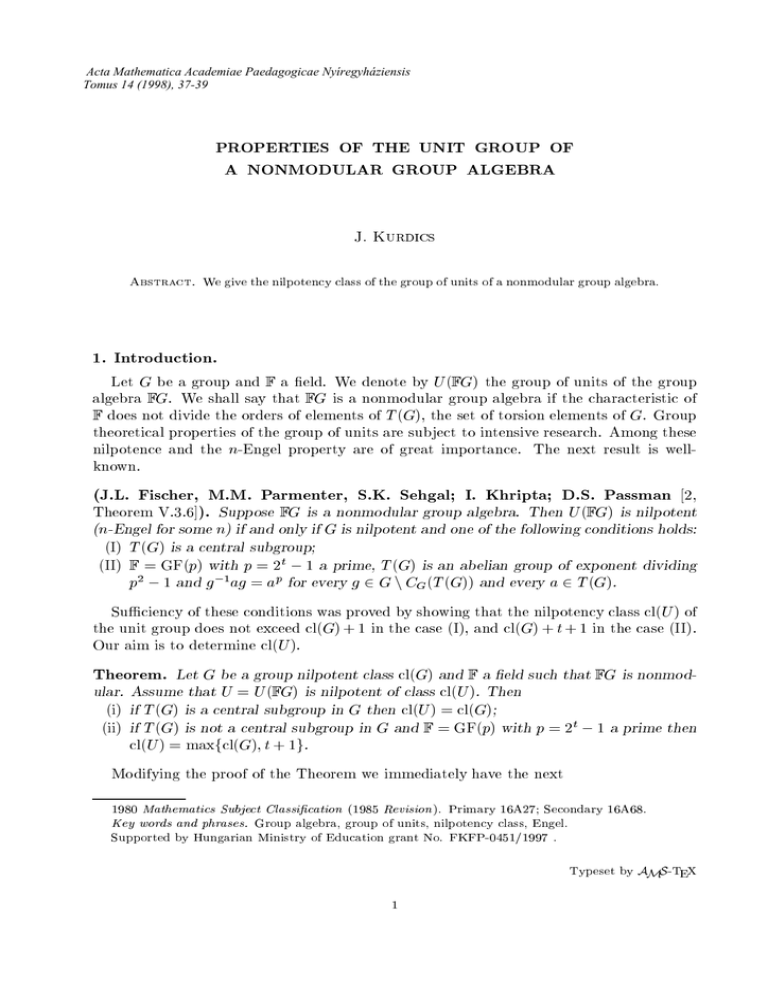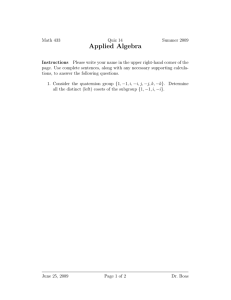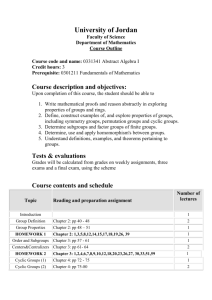PROPERTIES OF THE UNIT GROUP OF A NONMODULAR GROUP ALGEBRA 1. Introduction. G
advertisement

Acta Mathematica Academiae Paedagogicae Nyíregyháziensis Tomus 14 (1998), 37-39 PROPERTIES OF THE UNIT GROUP OF A NONMODULAR GROUP ALGEBRA J. Kurdics Abstract. We give the nilpotency class of the group of units of a nonmodular group algebra. 1. Introduction. Let G be a group and F a eld. We denote by U (F G) the group of units of the group algebra F G. We shall say that F G is a nonmodular group algebra if the characteristic of F does not divide the orders of elements of T (G), the set of torsion elements of G. Group theoretical properties of the group of units are subject to intensive research. Among these nilpotence and the n-Engel property are of great importance. The next result is wellknown. (J.L. Fischer, M.M. Parmenter, S.K. Sehgal; I. Khripta; D.S. Passman [2, Theorem V.3.6]). Suppose F G is a nonmodular group algebra. Then U (F G) is nilpotent (n-Engel for some n) if and only if G is nilpotent and one of the following conditions holds: (I) T (G) is a central subgroup; (II) F = GF(p) with p = 2t , 1 a prime, T (G) is an abelian group of exponent dividing p2 , 1 and g,1ag = ap for every g 2 G n CG (T (G)) and every a 2 T (G). Suciency of these conditions was proved by showing that the nilpotency class cl(U ) of the unit group does not exceed cl(G) + 1 in the case (I), and cl(G) + t + 1 in the case (II). Our aim is to determine cl(U ). Theorem. Let G be a group nilpotent class cl(G) and F a eld such that F G is nonmodular. Assume that U = U (F G) is nilpotent of class cl(U ). Then (i) if T (G) is a central subgroup in G then cl(U ) = cl(G); (ii) if T (G) is not a central subgroup in G and F = GF(p) with p = 2t , 1 a prime then cl(U ) = maxfcl(G); t + 1g. Modifying the proof of the Theorem we immediately have the next 1980 Mathematics Subject Classication (1985 Revision ). Primary 16A27; Secondary 16A68. Key words and phrases. Group algebra, group of units, nilpotency class, Engel. Supported by Hungarian Ministry of Education grant No. FKFP-0451/1997 . Typeset by AMS-TEX 1 2 J. KURDICS Corollary. Let G be an n-Engel group and F a eld such that F G is nonmodular. Assume that U = U (F G) is m-Engel for some m. Then (i) if T (G) is a central subgroup in G then U is n-Engel; (ii) if T (G) is not a central subgroup in G and F = GF(p) with p = 2t , 1 a prime then U is maxfn; t + 1g-Engel. 2. Proof of the Theorem. Let cl(G) = n, T = T (G) and x1 ; x2; : : : ; xm+1 2 U , where m = n in the case (I) and m = maxfn; t + 1g in the case (II). As the kth term of the lower central series of U is generated by the commutators of weight k, to prove cl(U ) m we must show (x1; x2; : : : ; xm+1) = 1. Since in either cases (I) and (II) all idempotents of F T are central, the requirements of [1, Lemma 1.2] are satised and we can write r X x = i j =1 i j gi j ej ; where i j 2 U (F T ), gi j 2 G and the ej are pairwise orthogonal idempotents with sum 1. First assume (I). Since T is central and cl(G) = n = m (x1; x2; : : : ; xm+1 r X ) = (g j =1 1 j ; g2 j ; : : : ; gn+1 j )ej = 1: Clearly, cl(U ) cl(G), hence we have the statement (i) of the Theorem. Now assume that (II) 2holds and T is noncentral. Pick g 2 G wich does not centralize T . Clearly, g,2ag2 = ap = a for any a 2 T , and therefore G=CG (T ) is of exponent 2, G0 CG (T ). We have a 2 (G) \ T if and only if g,1ag = ap = a i.e. p , 1 0(mod jaj); consequently P (G) \ T = fa 2 T j jaj j p , 1g. Let = i ai 2 U (F T ) with i 2 F . Obviously, X p ap ), p2 ,1 = ( 2 i 2 1 X a ), =( i i 1 =1 and U (F T ) has exponent dividing p2 , 1. Let T1 be a nite subgroup of T noncentral in G. Then F T1 is a direct sum of copies of GF(p) and GF(p2 ). Since the exponent of T1 does not divide p , 1, there is, in fact, a direct summand isomorphic to GF(pP2 ). Therefore U (F T ) is of exponent p2 , 1 If g2; g3; : : : ; gk+1 2= CG (T ) then gj,1gj = i api = p , (; gj ) = p,1 and k,1 t,1 (; g2; : : : ; gk+1) = (p,1)(,2) ; (; g2; : : : ; gt+1) = (p,1)(,2) ; (; g2; : : : ; gt+2) = 1: (1) If is of order p2 , 1 and g 2= CG (T ) then (; g; t) 6= 1, and hence cl(U ) t +1. Obviously, cl(U ) cl(G), therefore cl(U ) m. PROPERTIES OF THE UNIT GROUP OF A NONMODULAR GROUP ALGEBRA 3 Let g1; g2; : : : ; gk 2 G and 1 ; 2; : : : ; k 2 U (F T ). Note that G normalizes and G0 centralizes U (F T ). We have (1 g1; 2g2) = (1 g1; g2)(1 g1; 2)g2 = (1 ; g2)g1 (g1; g2)(g1; 2)g2 = = (1; g2)g1 (g1; 2)g2 (g1; g2) = (g1; g2); where = (1 ; g2)g1 (g1; 2)g2 2 U (F T ). Furthermore, with k 3, we have wk = (1 g1; 2g2; : : : ; k gk ) = (; g3; : : : ; gk )(g1; g2; : : : ; gk ): We prove wm+1 = 1: (2) Clearly, (g1; g2; : : : ; gm+1) = 1 as m n 2, and wm+1 = (; g3; : : : ; gm+1). If g1 2 CG (T ) then = (1 ; g2) and wm+1 = (1; g2; : : : ; gm+1) = 1 by (1) as m t + 1. Similarly, if g2 2 CG (T ) then = (g1; 2) and wm+1 = (g1; 2; g3; : : : ; gm+1) = 1 by (1). If gj 2 CG (T ) for some 3 j m + 1 then, clearly, wm+1 = 1. Suppose that none of the gj are in CG (T ). Then = (p1,1 )g1 (12,p )g2 = 11,p p2,1 = (,1 12 )p,1 = (,1 1 2 ; g2); and, by (1), wm+1 = (; g3; : : : ; gm+1) = (,1 1 2 ; g2; : : : ; gm+1) = 1: Clearly, (x1 ; x2; : : : ; xm+1 r X ) = ( j =1 1 j g1 j ; 2 j g2 j ; : : : ; m+1 j gm+1 j )ej : By (2) this commutator vanishes, which proves cl(U ) m. The statement (ii) of the Theorem is clear, and the proof of the Theorem is complete. References 1. Bovdi, A. A., Khripta, I. I., Engel properties of the multiplicative group of a group algebra, Math. USSR Sbornik 72 (1992), 121-133. 2. S. K. Sehgal, Topics in Group Rings, Marcel Dekker, New York, 1978. Department of Mathematics Bessenyei College Nyregyhaza, Hungary E-mail : kurdics@ny1.bgytf.hu (Received October 7, 1997)





